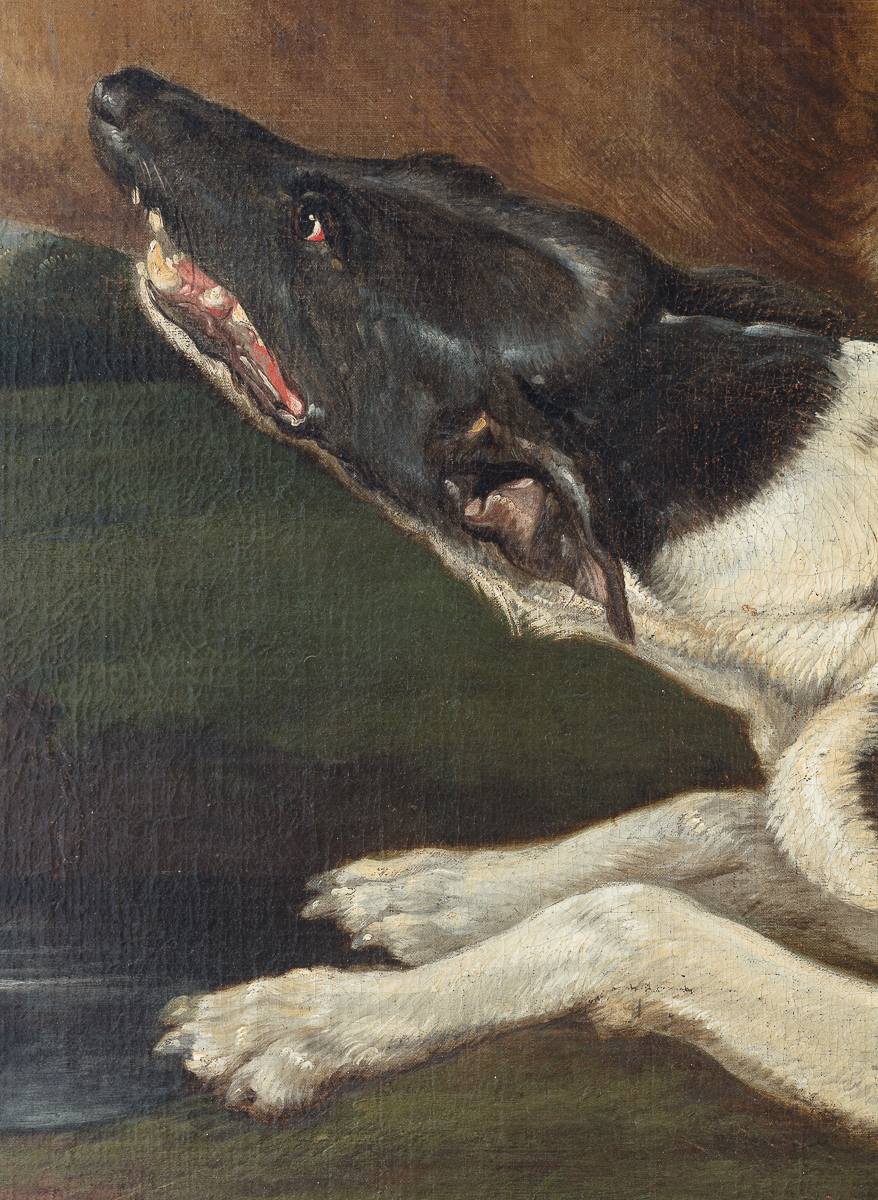Oil on Canvas; Hounds Chasing a Stag, Studio of Frans Snyders (Antwerp 1579-1657)
This powerful hunting scene is closely associated to the work of Antwerp-born seventeenth century painter and draughtsman Frans Snyders, widely considered the “progenitor of Flemish Baroque still-life and animal painting.”
Having grown up surrounded by artists, Snyders was initially apprenticed to Pieter Brueghel the Younger (1564-1637/38), scion of a well-established family of painters. Like many of his contemporaries in Northern Europe, to complete his education he then travelled to Italy, staying mainly in Rome and Milan (1608-09). Once back in Flanders, his profile as a skilled young painter – who had refined his craft by studying the masters of Italian art – came to the attention of Sir Peter Paul Rubens (1577-1640), in whose Antwerp studio Snyders entered as an assistant in about 1610, and with whom he would go on to collaborate on a number of important commissions for years to come. In 1611, Snyders further strengthened his ties with the local community of painters by marrying Margaretha de Vos, sister to Cornelis and Paul de Vos, two artists with whom he would also regularly collaborate.
Thanks to the lessons learned in Italy and in Rubens’ studio, Snyders soon achieved the ability to create rhythmic and dynamic compositions, infused with vibrant colours and powerful naturalistic effects. Centred on the theme of the still life, his market scenes and representations of richly stocked pantries and larders embodied the buoyant and confident spirit of seventeenth-century Antwerp, a trading port with a wealthy merchant class and aristocracy (Still Life with Dead Game, Fruits, and Vegetables in a Market, 1614, The Art Institute of Chicago; Still-Life with Fowl and Game, 1614, Wallraf-Richartz Museum, Cologne). Flowers from all seasons and dead game are portrayed alongside baskets overflowing with fruit, precious gilt vessels and Chinese Wanli porcelain, in compositions sometimes enlivened by the presence of a servant, a maid or an opportunistic cat (Pantry Scene with a Page, c. 1612, The Wallace Collection, London; Still-Life with Crab, Poultry, and Fruit, c. 1615-20, Staatlichen Museen, Berlin).
Influenced by Rubens’ majestic hunting scenes and mythological compositions – such as Diana Returning from the Hunt (c. 1615, Gemäldegalerie Alte Meister, Dresden), for which he painted the dead game – throughout the 1610s Snyders increasingly dedicated himself to the representation of live animals, primarily predators and their prey, responding to growing demand by patrons that wished to decorate the walls of their lavish country residences. Thanks to his success in this field, and to the continued interest in his market scenes, by 1619 Snyders was able to join the Antwerp Painters’ Guild, rising to the position of Dean in 1628. Stylistically, his compositions achieved an ever-greater sense of grandeur, with more fluid brushwork and an increasingly vivid palette, culminating in 1636 with the commission of nearly sixty paintings – to be done in collaboration with Rubens – for King Philip IV of Spain’s hunting-lodge, the Torre de la Parada, and the Palacio Real in Madrid.
Celebrated by contemporaries at home and abroad, Snyders continued to paint into his old age, and like many established artists ran a thriving workshop that often replicated the master’s compositions, sometimes with variations based on different designs and models available in the studio. In the case of the present painting, the subject is drawn from a hunting scene by Snyders now in the Pinacoteca di Brera in Milan, dated to about 1621 (fig. 1). The stag chased by hounds enjoyed particular popularity as a theme – no doubt owing to its characterisation as an aristocratic pursuit – and is brought to life with brilliant force here by the artist’s confident brushwork and palette.
Reference Bibliography
S. A. Sullivan, The Dutch Game Piece, Woodbridge, Suffolk, 1984, pp. 16-19
H. Robels, Frans Snyders: Stilleben- und Tiermaler, 1579-1657, Munich, 1989
S. Koslow, Frans Snyders, The noble estate. Seventeenth-century still-life and animal painting in the southern Netherlands, Antwerp, 1995
Height: 197.5cm, 6 foot 5 1/2″
Width: 267cm, 8 foot 9 1/2″
£92,000










